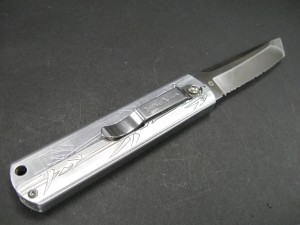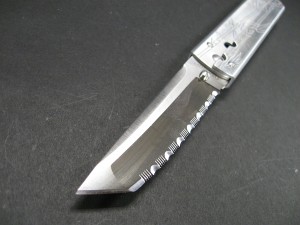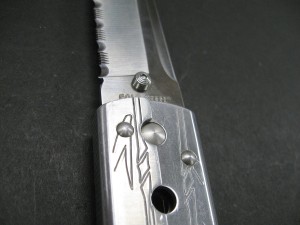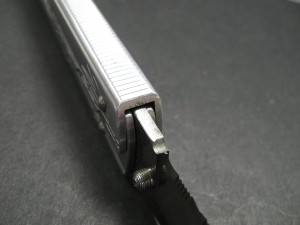The Cold Steel Triple Action is an obvious attempt to bring something new to the balisong (butterfly knife) demographic. It’s a sort of “Jacob’s ladder” design involving two pivots — one for the knife blade, and one for the handle half that opposes the blade, with the other handle half connecting the two. The design might at first glance seem awkward. With a little practice, however, the knife can be opened with as much flash and style as can a balisong, and it has a certain flair that makes it satisfying to those who enjoy these types of digital manipulations. I mention this at the outset because this knife really is a choice of style first and foremost; the mechanism has nothing functional to recommend it over other established designs. Clearly designed and styled to appeal to a martial arts audience, the Triple Action will forever be a niche knife. It may, in fact, be a niche knife in search of a niche to occupy.
Current production Triple Actions are of VG-1 steel. Closed, the knife is 5 inches long. It weighs less than four ounces, according to Cold Steel’s website. This is thanks to the aluminum handles, which are “roll engraved” to add pretty, vaguely oriental patterns to them. The blade on my sample, which bears Cold Steel’s proprietary serration pattern, is four inches long. This one is an Americanized tanto (a double-edged dagger model is also available) and is chisel-ground.
The large, stainless steel pocket clip is securely mounted over the blade pivot. Its orientation (and the side of the handle on which it is mounted) cannot be changed, but it doesn’t shift in place, either. The curve of the clip, near the end, fits my middle finger neatly and provides a point of index when holding the knife. This and the engraving provide a little traction, but the flat aluminum handle is very slippery. While comfortable (it’s flat and square, with rounded edges and some very light grooves cut into the spines of the handle halves), it never feels particularly secure. I always feel like the knife is going to get away from me when I wield it.
The chisel-ground tanto blade performs as do any of the other chisel-ground tanto blades Cold Steel produces. It cuts and tears well, thanks to the serrations, but of course is biased in one direction when slicing because of the chisel grind. It penetrates well (if I remember correctly, Lynn Thompson stabs the knife through several layers of leather in one of the company’s Proof videos) and takes a nice, sharp edge. It has no true belly for slicing, though there is a very subtle curve where the primary and secondary edges meet (meaning this secondary tip is less pronounced than on some Americanized tantos). I would consider the knife a light-duty utility blade, when used in this capacity, and that is what I have used it for — cutting cardboard, paper, packing material, and even fruit and vegetables. I used stacked layers of cardboard to test penetration on the thrust.
The knife has no guard, and this is not uncommon for tanto-blade “martial arts” knives (the Triple Action definitely ranks among such). This means you’ve either got to cap the butt of the open knife when thrusting, or be very, very careful (and grip the thing like you’re trying to choke it to death).
The Triple Action is held together with Allen-head screws. There is a graduated thumb stud, too, for opening the knife manually (meaning to open it carefully in stages, rather than flipping it open).
The lightweight aluminium handles are really the weakest part of the Triple Action, and it is here that the knife fails to move beyond “martial arts toy” to true “tactical knife.” The handles simply don’t hold up to extended use. They tend to bang themselves apart and, worse, the knife blade itself cuts the handles if the knife is opened inexpertly. Over time, my Triple Action has developed a series of small cuts in the aluminum. The blade edge has suffered accordingly.
Those cuts occur whenever the knife jams up during an attempt to flip it open. When the knife opens properly, it does so very quickly and seemingly by magic. When it doesn’t, however, it either fails to open completely (a failure to close the handles all the way, driven by the lack of traction in gripping those handles) or the blade snags the handle and lodges there, cutting deeply into the softer metal.
The Triple Action is a lot of fun. I enjoy playing around with it. Open, it’s a reasonably good live training blade (though, again, the slippery aluminum handles should give one pause). Closed, it’s even a passable pocket stick. The problem, however, is that there’s no reason you would carry this knife, because there’s no way it can ever be a truly reliable tactical blade. The risk of fumbling the opening, or losing your grip on the knife, is simply too great. This relegates the Triple Action to the status of toy rather than tool.
It’s fun, sure, but I can’t help but think the Triple Action is still searching for a niche to serve.



